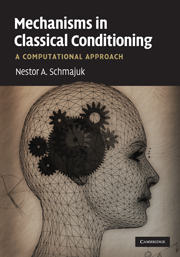Book contents
- Frontmatter
- Contents
- Preface
- Acknowledgments
- Abbreviations
- Part I Introduction
- Part II Attentional and associative mechanisms
- 2 An attentional–associative model of conditioning
- 3 Simple and compound conditioning
- 4 The neurobiology of fear conditioning
- 5 Latent inhibition
- 6 The neurobiology of latent inhibition
- 7 Creativity
- 8 Overshadowing and blocking
- 9 Extinction
- 10 The neurobiology of extinction
- Part III Configural mechanisms
- Part IV Attentional, associative, configural and timing mechanisms
- Part V Conclusion: mechanisms of classical conditioning
- References
- Author Index
- Subject Index
6 - The neurobiology of latent inhibition
from Part II - Attentional and associative mechanisms
Published online by Cambridge University Press: 23 May 2010
- Frontmatter
- Contents
- Preface
- Acknowledgments
- Abbreviations
- Part I Introduction
- Part II Attentional and associative mechanisms
- 2 An attentional–associative model of conditioning
- 3 Simple and compound conditioning
- 4 The neurobiology of fear conditioning
- 5 Latent inhibition
- 6 The neurobiology of latent inhibition
- 7 Creativity
- 8 Overshadowing and blocking
- 9 Extinction
- 10 The neurobiology of extinction
- Part III Configural mechanisms
- Part IV Attentional, associative, configural and timing mechanisms
- Part V Conclusion: mechanisms of classical conditioning
- References
- Author Index
- Subject Index
Summary
Following the ideas proposed in Chapter 4, this chapter applies the “conceptual nervous system” provided by the SLG model in order to establish brain–behavior relationships during latent inhibition. Here (a) we describe possible neural substrates for some of the variables in the SLG model; (b) based on those assumptions we use of the model to explain the effects of manipulations of the dopaminergic [DA] system, the hippocampus and the nucleus accumbens on LI; and (c) we apply the model to the description of some of the positive symptoms of schizophrenia.
The neural substrates of latent inhibition
In order to extend the application of the SLG model from the purely behavioral domain to the neurophysiological domain, we defined a mapping function between psychological and neurophysiological spaces that establishes where psychological variables are represented in the brain. Schmajuk, Cox and Gray (2001; Schmajuk et al.,2004) mapped nodes and connections in the SLG network onto the brain circuit, as shown in Figure 6.1. The participation of the brain regions in this circuit in LI, a combination of those proposed by Gray et al. (1997) and Weiner and Feldon (1997), was later confirmed by Puga et al. (2007) using cytochrome oxidase histochemistry in mice. Importantly, in line with our approach, according to Puga et al. (2007) their data suggest that LI is the consequence of a reduced processing of the CS.
- Type
- Chapter
- Information
- Mechanisms in Classical ConditioningA Computational Approach, pp. 93 - 118Publisher: Cambridge University PressPrint publication year: 2010



